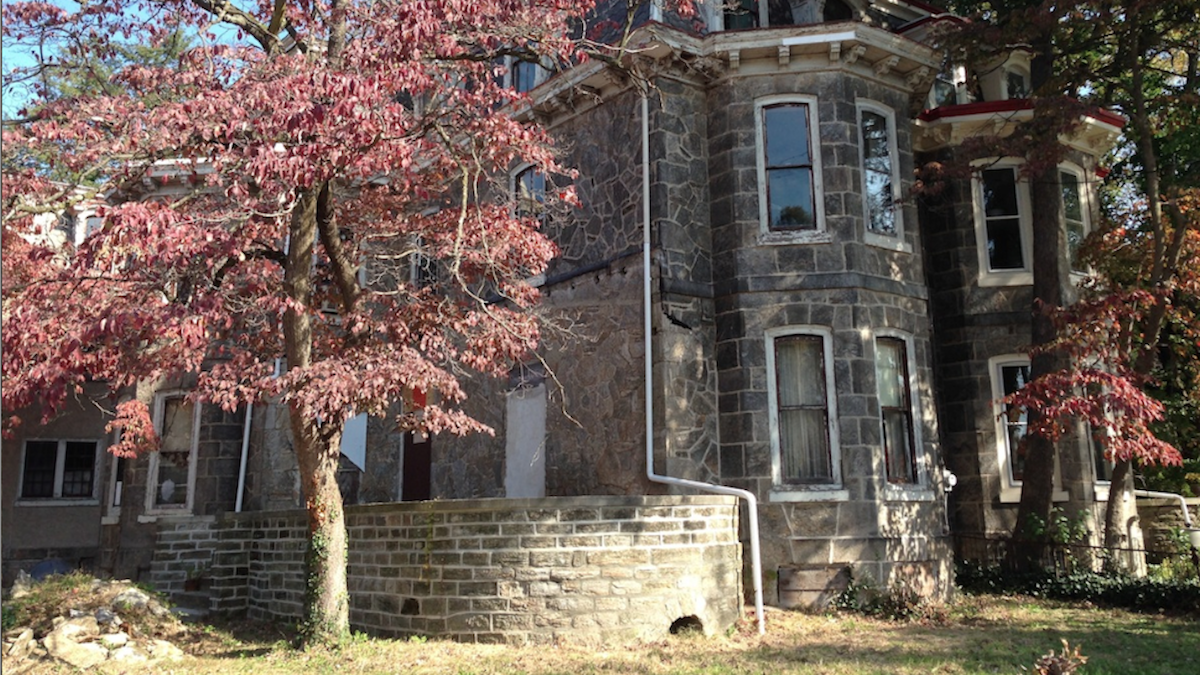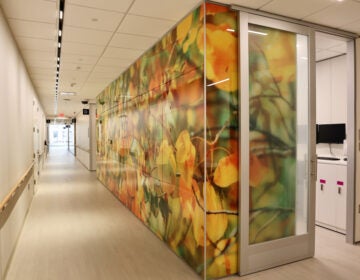After years of neglect, new owners have big plans for blighted house in Penn-Knox

The stone house standing on the corner of Knox and Coulter Streets was built in 1871 and was owned by Francis and Thomas Cope, members of a prominent family of merchants in Philadelphia. (Neema Roshania/WHYY, file)
A Germantown house that had been considered a blight on the neighborhood has finally changed hands and is on its way to rehab.
Over many years, the house at 5357 Knox Street had required 11 visits from Licenses & Inspections cleanup crews, was the cause of 20 court hearings, and incurred 10 liens against the property. Longtime owner Anthony Byrne was cited for a wide range of maintenance violations, including unsafe structural issues. In 2013, in the midst of a court case, Byrne transferred ownership of the house to his daughter Deirdre.
And it is Deirdre Byrne who has finally sold the property to neighbor Robert McCormac, whose home faces the former Byrne house.
According to McCormac, Deirde Byrne, who has strong family ties to the house, is the “hero of the neighborhood. She made the move, however emotional it was for her.”
Checkered history
The stone house standing on the corner of Knox and Coulter Streets was built in 1871 and was owned by Francis and Thomas Cope, members of a prominent family of merchants in Philadelphia. The building was listed on the Philadelphia Register of Historic Places in 1966. The Penn-Knox section of Germantown has never been designated a historic district, but it has many historically certified structures.
About 19 years ago, Julie Baranauskas moved into the house at 5355 Knox St., the twin connected to the Byrne property. The Byrne family had already moved out, but Anthony retained ownership while allowing the structure to deteriorate inside and out.
In 2003, Anthony Byrne left the water running in the unheated house and the third-floor pipes burst, flooding both his and his neighbor’s homes. Baranauskas was forced to move out for four months during the cleanup and mold remediation.
There have also been leaks from her neighbor’s roof that have infiltrated her house, as well as concerns over fire. Anthony Byrne used his house to store stacks of paper and debris, Baranauskas and her neighbors have said.
Protracted negotiations
Anthony Byrne received and turned down numerous offers for the property over the years. During a court case brought by L&I in 2012, Anthony transferred ownership to Deirdre.
McCormac was among those interested in purchasing the Bryne house, and when he heard from an area real estate agent last year that Deirdre was planning to sell, he contacted her.
“I told her how much I appreciate the architecture and layout of the place, and that I’d love to turn it into something spectacular,” McCormac said.
For six months, the owner said she was not going to sell. “Then she said she was willing,” McCormac said. He would not reveal the final price for the property, but he said Baranauskas helped him make the purchase.
Baranauskas said the property comes with encumbrances against it, the result of years of L&I violations and court costs. McCormac “took it as is,” she said.
The Byrne family did not respond to requests for comment for this article.
Curb appeal
Baranauskas feels an overwhelming sense of gratitude to McCormac. “Not having to worry about what’s going on next door is a huge relief,” she said.
The process of cleaning out the house has already started. Baranauskas said clearing debris in the space from the entrance to the staircase filled a dumpster in just four hours. She also said the interior of the 11-bedroom house was larger and grander than neighbors realized.
Complete rehabilitation of the house will take five years, McCormac estimated. “My dream is to turn it into three apartments without ever having to change the interior architecture of the house. My immediate goal is to turn the property from an eyesore into a house with very nice curb appeal.”
McCormac did much of the work on his own home at 151 West Coulter Street when he bought that property, which he said had previously been a crack house. “I learned more about construction than I ever wanted to know.”
The property on Knox Street still has its original architectural details, including the moldings, doors and staircase, McCormac said. “All the bones are there…There are some bad rooms, but overall it’s super-solid.”
Baranauskas believes Penn-Knox has already benefited from the transfer of ownership. “And from a personal point of view, my house was saved when Rob got a successful deal over there.”
McCormac turns the credit around to the seller, Deirdre Byrne. “She was very emotional about the sale,” he said. “She wanted what was best for the house and the neighborhood.”
PlanPhilly is now a project of WHYY/NewsWorks. It began in 2006 as an initiative of Penn Praxis inside the University of Pennsylvania School of Design. Though now part of WHYY, PlanPhilly still works closely with Penn Praxis in covering planning, zoning and development news. Contact Alan Jaffe at ajaffe@planphilly.com.
WHYY is your source for fact-based, in-depth journalism and information. As a nonprofit organization, we rely on financial support from readers like you. Please give today.




